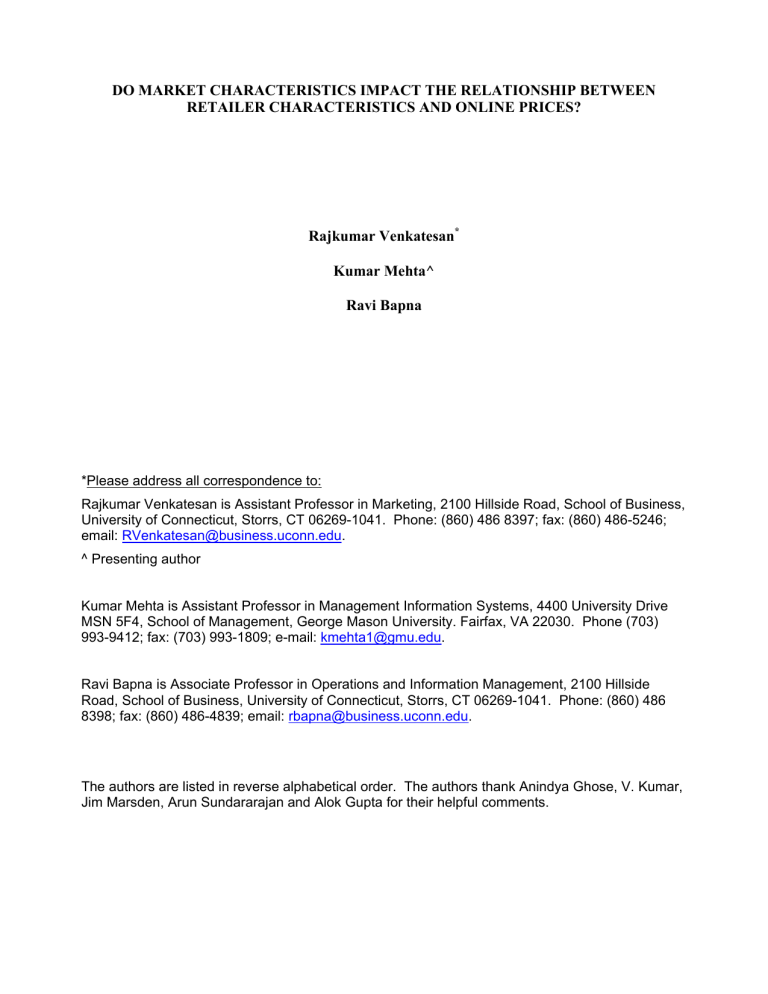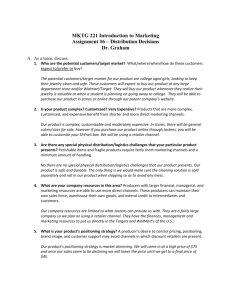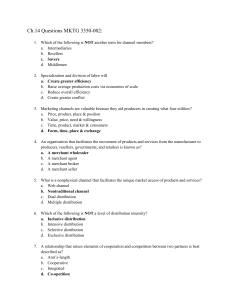DO MARKET CHARACTERISTICS IMPACT THE RELATIONSHIP BETWEEN Rajkumar Venkatesan

DO MARKET CHARACTERISTICS IMPACT THE RELATIONSHIP BETWEEN
RETAILER CHARACTERISTICS AND ONLINE PRICES?
Rajkumar Venkatesan
*
Kumar Mehta^
Ravi Bapna
*Please address all correspondence to:
Rajkumar Venkatesan is Assistant Professor in Marketing, 2100 Hillside Road, School of Business,
University of Connecticut, Storrs, CT 06269-1041. Phone: (860) 486 8397; fax: (860) 486-5246; email: RVenkatesan@business.uconn.edu
.
^ Presenting author
Kumar Mehta is Assistant Professor in Management Information Systems, 4400 University Drive
MSN 5F4, School of Management, George Mason University. Fairfax, VA 22030. Phone (703)
993-9412; fax: (703) 993-1809; e-mail: kmehta1@gmu.edu
.
Ravi Bapna is Associate Professor in Operations and Information Management, 2100 Hillside
Road, School of Business, University of Connecticut, Storrs, CT 06269-1041. Phone: (860) 486
8398; fax: (860) 486-4839; email: rbapna@business.uconn.edu
.
The authors are listed in reverse alphabetical order. The authors thank Anindya Ghose, V. Kumar,
Jim Marsden, Arun Sundararajan and Alok Gupta for their helpful comments.
DO MARKET CHARACTERISTICS IMPACT THE RELATIONSHIP BETWEEN RETAILER
CHARACTERISTICS AND ONLINE PRICES?
Industry surveys show that online firms have transitioned from the initial phase of investment and brandbuilding to the profit maximization phase. Profitability and sales reports published from 2001 to 2003 suggest that Internet-based retailing has now firmly established itself as a increasingly profitable marketplace. In light of this maturation, it is imperative to ask whether the extant understanding of retailer pricing strategies comprehensively explains the online retailers’ pricing behavior. It has been suggested that descriptive research on the determinants of retailer pricing strategies aids managers in profiling their pricing practices and predicting competitors’ behavior (Shankar and Bolton 2004). Importantly, the Internet as a retailing channel is significantly different from the traditional marketplace; in that it is characterized by vastly increased availability of information regarding product attributes, prices and retailer service quality metrics. A key challenge has been to obtain an understanding of the retailers’ continued ability to price differentiate in the face of lowered search costs in Internet markets . The main findings to date have been that
–a) price dispersion in Internet markets is persistent with time, b) in some, but not all, instances retailer service quality explains some of the variance in online prices, and c) the transaction channels provided by a retailer and level of competition matter (see Pan et al. 2004 for a detailed review).
We propose that market characteristics interact with retailer characteristics to determine online prices. The retailer characteristics examined include - service quality of a retailer, channels of transaction provided by a retailer and the size of a retailer. The market characteristics capture the level and nature of competition, and the price level of a product. We utilize a Hierarchical Linear Model framework for capturing and testing the proposed interactions. The better fit between the model and the online market structure is reflected by a twenty-five percent increase in explainable price dispersion over results from comparable studies. Our study demonstrates that while retailer characteristics do impact online prices, this influence is significantly enhanced or diminished by the accompanying market characteristics.
CONCEPTUAL MODEL
DATA
We collected 22,209 price quotes, for 1,880 products from 233 retailers. For our analyses we only use prices quoted for items identified as “new” by retailers other than refurb/discounters. We excluded retailers with missing service quality ratings . Though most retailers provide the price search engines with product information such as – new, refurbished, the retailers primarily offering refurbished items tend not to do so.
Refurbished and used products differ from new products with regards to product quality and are generally
1
sold at lower prices, thereby leading to a bias in the price dispersion measure. We therefore conducted a manual verification of each retailer’s website to identify refurb/discounters, and removed them from our analyses. The impact of the bias reduction yielded a total of 13,393 price points suitable for analysis. To assess the qualitative impact of the bias reduction process we examined the dispersion of prices in the collected data and the analyzed data and found no significant difference between them. Although no significant difference was observed between the data, we believe that the bias reduction provides for more reliable and credible parameter estimates in our analyses.
FINDINGS
Our study extends previous findings on how retailer characteristics such as service quality and channels of transaction (Pan et al. 2002; Ancarani and Shankar 2004) impact the prices. We also show how market characteristics such as number of competitors influence price dispersion in online markets. In particular, our proposed comprehensive model explains greater amount of variance in prices and provides empirical evidence that retailer and market characteristics interact to determine the prices charged by a retailer. Our key findings include: 1) a positive influence of service quality on prices across several product categories; 2) similar to prior findings (Pan et. al 2002), an increase in number of competitors induces a downward pressure in prices for all retailers, albeit at a decreasing rate; 3) for the first time in the literature, we show how the increase in scope for service differentiation is leveraged by high service quality retailers to increase their prices particularly in face of high competition; 4) interestingly we find that low service quality retailers in fact seek higher prices in markets characterized by either a large number of competitors and low variation in service quality or in markets with a large variance in service quality and few competitors, and 5) national brick-and-click retailers reduce their prices in face of increasing competition in form of other national brickand-click retailers. The findings from our study pertain to retailer characteristics, market characteristics and their interactive effects, thereby highlighting the importance of incorporating the hierarchical structure of the market in a unified empirical model when studying pricing strategies of online retailers.
2






